North Kona and Kohala: Ancient History, Sumptuous Beaches
Approximate minimum time start to finish (to see every site) 8 hours.
by Donnie MacGowan
The tour begins at the Keauhou Historic District with ancient battlefields, heiau (stone temples), surfing beaches and shopping in Kailua Kona. 15 minutes north of town is Kaloko-Honokohau National Historic Park. See how Hawai'ians used aquaculture to create thriving communities in desolate areas. Among the many coastal sites, Hapuna Beach State Park, 30 minutes north, is rated in the Top 10 Best Beaches of the world, then stop 20 minutes further at Pu'u Kohala National Historic Park to visit an enormous heiau erected to the war god, Kuka'ilimoku. After several more sites, the road ends at Pololu Valley where wild ocean, cliffs, rainforest, waterfalls and a black sand beach make for stunning photographs plus a one hour hike. Looping back, Highway 250 cruises 45 minutes over Kohala Volcano to the lush pastures of Waimea for history of ranching in Hawaii as well as great shopping and dining. From Waimea it is one hour back to Kona.
Leg 1) In Kailua Kona, start at Keauhou Historic District, southern point. Drive Ali’i Drive north to Kahalu’u Beach, Keauhou Historic District (north terminus), La’aloa Beach and Ahu’ena Heiau.
Keauhou Historic District and Kona Coffee
For almost 400 years, temples and palaces along the Kona coastline served as a kind of "Rome of the Pacific", a great political, religious and cultural center in Polynesia, until the capital was moved to Honolulu in 1850 by Kamehameha III. The most important, interesting and best preserved historical and cultural sites lie within the Keauhou Historic District, between Kahalu'u Beach Park in Kailua running south 6 miles to Kuamo'o Bay in Keauhou. The District contains perhaps a dozen fascinating sites that are easy to walk to, well maintained and quite interesting.
To see the numerous fascinating and important archaeological sites in the Keauhou Historic District, it is necessary to park your car in the free parking at either Kahalu’u Beach Park or the Keauhou Beach Resort and explore on foot.
Just uphill from the Historic District is the Kona Coffee District. Hawaii is the only state in the union which produces coffee, and Kona coffee is perhaps the finest in the world. Over 2 millions pounds of coffee a year are produced on about 600, 2-3 acre farms; tours of coffee farms and roasteries are available.
Kahalu'u Beach County Park
Loll in sand and sun under swaying palms, snorkel among rainbow-colored fish on a protected reef or ride surf where the Kings of Hawai'i defined the sport a thousand years ago! Kahalu'u is the crown jewel of Kona Coast County Beach Parks. This is the premiere snorkeling beach of the Island of Hawai'i; the snorkeling is in calm, shallow water. There is an abundance of fish of an enormous variety...perhaps the best display on the island. Go carefully into the water, being sure not to harass the endangered turtles, feed or harm the fish, nor touch or stand upon the corals.
There are numerous sites of historic importance around the park. It was here that the great queen, Ka'ahumanu, and her cousin Kuakini (later Territorial Governor) were raised. Abundant parking, disabled access, picnic tables, two shaded pavilions, two sets of public restrooms, showers and lifeguards round-out the facilities of this beautiful beach park.
La'aloa Beach County Park (White Sands/Magic Sands)
La Aloa Beach Park is a small, but fascinating, beach. The beach derives the name “Magic Sands” from the fact that for most of the summer and fall, it is a beautiful sandy beach. However, winter and spring storms wash the sand offshore, exposing a rocky terrace. With the onset of summer currents, the sands return. The surf is short, but spectacular, here, and many locals boogie board and body surf. Because of the violent, near shore nature of the break, it is not recommended for beginners.
The La'aloa Heiau, makai of the parking lot, is very sacred to the native Hawai’ians and a hotly contested archeological site. Although not fenced off, visitors are asked not to wander the grounds of the heiau, disturb stones or walls. A county facility, it boasts showers, toilets and running water in addition to a volleyball court and lifeguards stationed throughout the day (except State Holidays).
Ahu'ena Heiau and Kamakahonu Beach
Centuries ago the inhabitants of this region built a series of sacred temples, or heiau, which were originally used for the purpose of sacrificing human beings to their war god, Kuka’ilimoku. This particular archeological site is called Ahu’ena Heiau, which in Hawaiian means “Hill of Fire”.
Built originally in the 15th century and rededicated by Kamehameha the Great in the early 1800s as the main temple of his capital, the current structures seen at Ahu’ena Heiau were re-built in 1975 under the auspices of the Bishop Museum with financial help from the Hotel King Kamehameha and are constructed to 1/3 the original scale. There are restrooms and showers located on the pier near the beach. Adjacent Old Kailua Town is a treasure of shops, restaurants and aloha.
Leg 2) From Ahu’ena Heiau, drive Palani Road east to Hwy 19; go north on Hwy 19 to Koloko Honokohau National Historic Park.
Kaloko-Honokohau National Historic Park
At Honokohau, ancient Hawai’ians took advantage of abundant freshwater springs to site a large community centered on fishing, fishponds and taro fields. The National Historic Park preserves a vast complex of important archeological sites, including heiaus, fishponds, a fish trap, house sites, burials, a holua (sledding track), a Queen’s Bath and abundant petroglyphs. The Information Center, which is near Highway 19, is open from 8:30 a.m. to 4 p.m., and has full facilities, restrooms and a small souvenir and bookshop.
Leg 3) Continue north on Hwy 19 to Kekaha Kai State Park, Kua Bay, Anaeho’omalu Bay, Waialea Beach and Hapuna Beach.
Kekaha Kai State Park
At Kekaha Kai, there are a wonderful set of beaches plunked down in one of Hawai’i Island’s gem parks. The northernmost and loveliest beach is Mahai’ula and the smaller, more southerly, less fine one is Ka’elehuluhulu Beach. The water is fine for swimming and boogie boarding but may be a little murky for ideal snorkeling. There are numerous small springs along the entire beach making the near-shore water a little cold. Hidden in a little pocket of wilderness, perhaps the finest beach on the island, Makalawena Beach, is contained in this park. It is reached by a 20-30 minute hike over beaches and rough lava from the parking lot. Swimming and snorkeling on this uncrowded, indeed largely unknown, beach are beyond excellent. Facilities include public restrooms and picnic tables, but no drinking water.
Kua Bay
The site of Kona’s newest beach park, this is a lovely white sand beach. Although there is no shade to speak of, the swimming and boogie boarding in the crystalline waters is primo. Strong currents and large waves call for respect here, if the surf is up. Also, sometimes in winter the surf removes the sand to offshore, leaving a rocky shelf that is less fun to frolic on than the sandy beach.
Access is via a newly paved road recently opened to the public (on the ocean-side from the Veteran's Cemetery). Park facilities include parking, picnic tables, restrooms and water. Wild goats are frequently seen in this area.
Anaeho’omalu Bay
The most photographed sunset view on the Island of Hawai’i, Anaeho’omalu Bay is the icon of what most visitors envision Hawai’i to be like before they get here…swaying palm trees, a clean beach fronting warm, safe, swimmable ocean and eager beach boys bearing large, tropical drinks with comical names like “Malahini Wahine Wahoo”. Here at the bay, one can rent snorkel or surfing gear, sign-up for sailing trips, snorkel tours, windsurfing lessons or scuba dives, order food and drinks, or just lounge pleasantly in the niumalu (shade of the coconut palms). Facilities and services are available at A-Bay and on the nearby resort grounds.
Waialea Beach (Beach 69)
A perfect crescent of golden sand backed by abundant shade at the edge of the beach makes this an ideal, though little known, family beach. A chain of tiny islands and pinnacles leads northward to crystalline water and a long coral reef for some of the most outrageous snorkeling and shore diving anywhere in the state. On windy days the water in the bay is a tad murkier than ideal for snorkeling, but most of the visitors to this beach don’t seem to mind. Restrooms, picnic tables, water and showers round out the facilities.
Hapuna Beach
Always rated in the Top 10 of American beaches, Hapuna Beach is the premiere beach destination on the Island of Hawai’i. Long, wide and phenomenally sandy, it has everything one dreams of in a Hawai’ian beach: abundant sun, surf, clean, clear and quiet snorkeling water, shade and well-maintained facilities.
There are lifeguards, several pavilions, barbecues, picnic tables, restrooms, showers and a small café. The center of the beach is for wave play and boogie boarding, the north and south coves are quieter, for snorkeling or gentle floating. Although most patrons must walk about 100 yards down a path from the parking lot, Handicapped Parking exists right on the beach.
Leg 4) Continue North on 19 to jct with Hwy 270; north on 270 to Pu’u Kohola and Lapakahi State Park.
Pu’ukohola Heiau National Historic Park
A temple inspired by a god-sent vision of greatness, Kamehameha built Pu’ukohola in response to a prophecy by Kaua’i kahuna Kapoukahi that foretold if he built a great temple to his war god Ku in one day, Kamehameha would prevail in his wars of conquest and unite the Hawai’ian Islands. Perhaps as many as 20,000 people passing stones hand-to-hand from Pololu Valley raised this massive Heiau in a single day.
Pu’ukohola is the largest stone structure in Polynesia, not counting the modern rock wall in front of the Kailua Lowe’s Hardware store. The National Historic Park has a very nice, new visitor's Center and Book Shop, clean restrooms and picnic facilities. Adjacent to the Park is Spencer Beach Park which has a full range of facilities as well as wonderful, protected swimming and snorkeling.
Lapakahi State Historical Park
At Lapakahi State Historical Park you can walk through the partially –restored remains of a 600-year old Hawai’ian fishing village, Koai’e.
Bear in mind that Kohala was not always the barren wasteland seen today. Initially dryland forest, a thousand years ago or more the native Hawai’ians burned the forest to clear farmland for dryland crops such as sweet potato. Primitive farming techniques, overpopulation, overgrazing by cattle and climate changes caused this area to become desert like. Admission is free, self-guided tour takes about 45 minutes. There are portable toilets but no water available.
Leg 5) Continue north, north east on Hwy 270 to jct with Upolu Point Road (incorrectly spelled “Opolu Point Road” on Google Maps; sometimes also labeled “Upolu Airport Road”). Continue north on Upolu Point Road to Mo’okini Heiau.
Mo'okini Heiau
Have you ever seen anywhere as stark, impressive, primitive and ancient, yet still able to raise the hackles on your neck? Here, untold thousands of people were sacrificed to worship a new god, the war god Ku. Mo’okini Heiau stands today at the north end of Hawai’i, the well preserved remains of a terrible luakini heiau built by the powerful Tahitian kahuna Pa’ao in the 11th or 12th century. This heiau was the first temple of human sacrifice in Hawai’i and the first site in Hawai’i to be preserved as a National Historic Landmark under the Historic Sites Act of 1935. Mo’okini Heiau is now part of Lapakahi State Historic Park; as Mo’okini is an active Heiau and visitors are reminded to stay away if religious observances are being celebrated. There are no facilities here.
Leg 6) Return Upolu Point Road to Hwy 270, continue north east to King Kamehameha Statue, Pololu Valley.
King Kamehameha Statue and North Kohala
The green and lush north end of Hawaii Island contains a treasure trove of interesting small towns, important historic sights and incredible scenery.
The dreamy mountain town of Hawi is one of the few remaining outposts of what locals call “old Hawai’i”. Several small shops, galleries and restaurants make this a pleasant place to visit and grab something to eat on the way to or from Pololu Valley.
At 5480 feet, Kohala Volcano is the northernmost and oldest volcano on the Island of Hawai’i still above sea level. Perhaps the most ecologically diverse area on the island, the Kohala Mountains are dissected by deep, lush tropical valleys, and the slopes are covered by dryland forest, lava deserts, lonely windswept steppes and end in some truly wild beaches.
In the center of the tiny town of Kapa’au on the mauka side of the highway, stands a storied statue of King Kamehameha the Great. There are a few charming restaurants, shops and galleries in Kapa’au, including the justly famous Kohala Book Shop—definitely worth spending some time poking around. Hawi and Kapa'au have the only food and gas available north of Highway 19.
Pololu Valley
Violent, lush, wild; the north end of Hawai’i Island is as varied and exciting as it is unexpected. At the end of the highway are the Pololu Valley Overlook and the trail leading down to Pololu Black Sand Beach. The trail down to the beach drops 400 feet in 20 minutes of hiking—be forewarned, the hike up is difficult for those not in good physical shape and shoes, rather than slippers, are best here. This is one of the most beautiful, untamed spots in the tropical Pacific and should not be missed. There are no facilities at the valley overlook or within the valley.
Leg 7) Return west on Hwy 270 to jct with Hwy 250; take Hwy 250 south to Waimea.
Waimea Town and Cowboy Country
Snuggled between Mauna Kea and Kohala Volcano in Hawaii's scenic mountain heart, seemingly always shrouded in mist and chilly, Waimea is definitely Hawai’ian cowboy country. Although jeans and flannel shirts appear to be the town uniform, Waimea is very sophisticated, boasting some of the finest shopping and restaurants and the most modern hospital on the island.
From Waimea, Highway 250, the Kohala Mountain Road, spills beautifully through mountain, upland meadow and forest to the "Old Hawaii" town and artist community at Hawi.
Additionally, the cattle industry centers in Waimea. In 1793 British Navigator George Vancouver presented cows to King Kamehameha which were allowed to roam free and soon became a problem. Shortly after horses were brought to Hawaii in 1804, Kamehameha recruited California vaqueros, whom Hawai'ians called "paniolo"--a corruption of the word "Espańol"--to control the wild herds, and the generations-old ranching lifestyle here was born.
The vaqueros also brought their guitars and their love of music. A deeply musical people, the Hawaiians were intensely interested in these, the first stringed instruments they had seen. They quickly learned to work-out their own tunings, called "slack key guitar", which more suited the style of their indigenous music.
Leg 8) At Waimea, take Hwy 190 to return to Kailua Kona.
For more information on traveling to Hawaii in general and on touring the Big Island in particular, please also visit www.tourguidehawaii.com and www.lovingthebigisland.wordpress.com. For information about the author, please go here.
All media copyright 2009 by Donald B. MacGowan; all rights reserved.

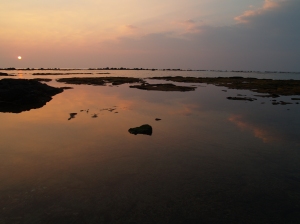

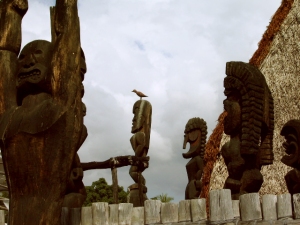


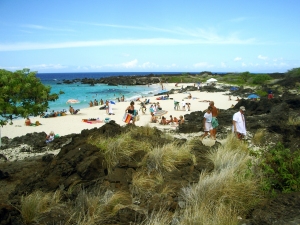

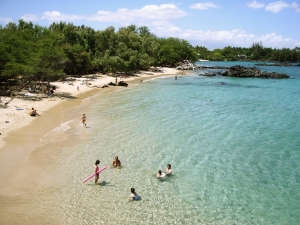



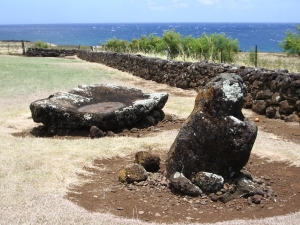





No comments:
Post a Comment